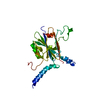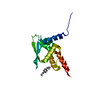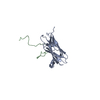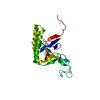[English] 日本語
 Yorodumi
Yorodumi- PDB-5nwm: Insight into the molecular recognition mechanism of the coactivat... -
+ Open data
Open data
- Basic information
Basic information
| Entry | Database: PDB / ID: 5nwm | ||||||
|---|---|---|---|---|---|---|---|
| Title | Insight into the molecular recognition mechanism of the coactivator NCoA1 by STAT6 | ||||||
 Components Components |
| ||||||
 Keywords Keywords |  SIGNALING PROTEIN / NCoA-1 / SIGNALING PROTEIN / NCoA-1 /  STAT6 / PAS-B domain / STAT6 / PAS-B domain /  transactivation domain / LXXLL motif transactivation domain / LXXLL motif | ||||||
| Function / homology |  Function and homology information Function and homology informationregulation of mast cell proliferation / mammary gland morphogenesis / cellular response to reactive nitrogen species / negative regulation of type 2 immune response / positive regulation of isotype switching to IgE isotypes / T-helper 1 cell lineage commitment / STAT6-mediated induction of chemokines / isotype switching to IgE isotypes / interleukin-4-mediated signaling pathway / labyrinthine layer morphogenesis ...regulation of mast cell proliferation / mammary gland morphogenesis / cellular response to reactive nitrogen species / negative regulation of type 2 immune response / positive regulation of isotype switching to IgE isotypes / T-helper 1 cell lineage commitment / STAT6-mediated induction of chemokines / isotype switching to IgE isotypes / interleukin-4-mediated signaling pathway / labyrinthine layer morphogenesis / regulation of thyroid hormone mediated signaling pathway / positive regulation of transcription from RNA polymerase II promoter by galactose / positive regulation of female receptivity / mammary gland epithelial cell proliferation / hypothalamus development / male mating behavior / NR1H2 & NR1H3 regulate gene expression to control bile acid homeostasis / cell surface receptor signaling pathway via JAK-STAT /  estrous cycle / cellular response to Thyroglobulin triiodothyronine / Synthesis of bile acids and bile salts / Endogenous sterols / growth hormone receptor signaling pathway via JAK-STAT / Synthesis of bile acids and bile salts via 27-hydroxycholesterol / Synthesis of bile acids and bile salts via 7alpha-hydroxycholesterol / nuclear retinoid X receptor binding / NR1H3 & NR1H2 regulate gene expression linked to cholesterol transport and efflux / response to retinoic acid / estrous cycle / cellular response to Thyroglobulin triiodothyronine / Synthesis of bile acids and bile salts / Endogenous sterols / growth hormone receptor signaling pathway via JAK-STAT / Synthesis of bile acids and bile salts via 27-hydroxycholesterol / Synthesis of bile acids and bile salts via 7alpha-hydroxycholesterol / nuclear retinoid X receptor binding / NR1H3 & NR1H2 regulate gene expression linked to cholesterol transport and efflux / response to retinoic acid /  histone acetyltransferase activity / Recycling of bile acids and salts / regulation of cellular response to insulin stimulus / histone acetyltransferase activity / Recycling of bile acids and salts / regulation of cellular response to insulin stimulus /  histone acetyltransferase / cellular response to hormone stimulus / positive regulation of adipose tissue development / peroxisome proliferator activated receptor signaling pathway / positive regulation of neuron differentiation / RORA activates gene expression / histone acetyltransferase / cellular response to hormone stimulus / positive regulation of adipose tissue development / peroxisome proliferator activated receptor signaling pathway / positive regulation of neuron differentiation / RORA activates gene expression /  lactation / Regulation of lipid metabolism by PPARalpha / cerebellum development / Downstream signal transduction / BMAL1:CLOCK,NPAS2 activates circadian gene expression / SUMOylation of transcription cofactors / nuclear receptor coactivator activity / Activation of gene expression by SREBF (SREBP) / response to progesterone / nuclear estrogen receptor binding / lactation / Regulation of lipid metabolism by PPARalpha / cerebellum development / Downstream signal transduction / BMAL1:CLOCK,NPAS2 activates circadian gene expression / SUMOylation of transcription cofactors / nuclear receptor coactivator activity / Activation of gene expression by SREBF (SREBP) / response to progesterone / nuclear estrogen receptor binding /  nuclear receptor binding / hippocampus development / RNA polymerase II transcription regulatory region sequence-specific DNA binding / Heme signaling / mRNA transcription by RNA polymerase II / defense response / Transcriptional activation of mitochondrial biogenesis / nuclear receptor binding / hippocampus development / RNA polymerase II transcription regulatory region sequence-specific DNA binding / Heme signaling / mRNA transcription by RNA polymerase II / defense response / Transcriptional activation of mitochondrial biogenesis /  transcription coactivator binding / PPARA activates gene expression / Cytoprotection by HMOX1 / cerebral cortex development / response to peptide hormone / cellular response to hydrogen peroxide / Transcriptional regulation of white adipocyte differentiation / cytokine-mediated signaling pathway / RNA polymerase II transcription regulator complex / male gonad development / transcription coactivator binding / PPARA activates gene expression / Cytoprotection by HMOX1 / cerebral cortex development / response to peptide hormone / cellular response to hydrogen peroxide / Transcriptional regulation of white adipocyte differentiation / cytokine-mediated signaling pathway / RNA polymerase II transcription regulator complex / male gonad development /  Circadian Clock / response to estradiol / positive regulation of cold-induced thermogenesis / regulation of cell population proliferation / HATs acetylate histones / DNA-binding transcription activator activity, RNA polymerase II-specific / Circadian Clock / response to estradiol / positive regulation of cold-induced thermogenesis / regulation of cell population proliferation / HATs acetylate histones / DNA-binding transcription activator activity, RNA polymerase II-specific /  protein phosphatase binding / Interleukin-4 and Interleukin-13 signaling / Estrogen-dependent gene expression / protein phosphatase binding / Interleukin-4 and Interleukin-13 signaling / Estrogen-dependent gene expression /  transcription regulator complex / transcription regulator complex /  transcription coactivator activity / transcription coactivator activity /  protein dimerization activity / DNA-binding transcription factor activity, RNA polymerase II-specific / positive regulation of apoptotic process / RNA polymerase II cis-regulatory region sequence-specific DNA binding / DNA-binding transcription factor activity / protein dimerization activity / DNA-binding transcription factor activity, RNA polymerase II-specific / positive regulation of apoptotic process / RNA polymerase II cis-regulatory region sequence-specific DNA binding / DNA-binding transcription factor activity /  chromatin binding / chromatin binding /  chromatin / regulation of transcription by RNA polymerase II / positive regulation of DNA-templated transcription / negative regulation of transcription by RNA polymerase II / chromatin / regulation of transcription by RNA polymerase II / positive regulation of DNA-templated transcription / negative regulation of transcription by RNA polymerase II /  signal transduction / positive regulation of transcription by RNA polymerase II / protein-containing complex / signal transduction / positive regulation of transcription by RNA polymerase II / protein-containing complex /  nucleoplasm / identical protein binding / nucleoplasm / identical protein binding /  nucleus / nucleus /  plasma membrane / plasma membrane /  cytosol cytosolSimilarity search - Function | ||||||
| Biological species |   Homo sapiens (human) Homo sapiens (human) | ||||||
| Method |  SOLUTION NMR / SOLUTION NMR /  simulated annealing simulated annealing | ||||||
 Authors Authors | Russo, L. / Becker, S. / Griesinger, C. | ||||||
 Citation Citation |  Journal: Sci Rep / Year: 2017 Journal: Sci Rep / Year: 2017Title: Insight into the molecular recognition mechanism of the coactivator NCoA1 by STAT6. Authors: Russo, L. / Giller, K. / Pfitzner, E. / Griesinger, C. / Becker, S. | ||||||
| History |
|
- Structure visualization
Structure visualization
| Structure viewer | Molecule:  Molmil Molmil Jmol/JSmol Jmol/JSmol |
|---|
- Downloads & links
Downloads & links
- Download
Download
| PDBx/mmCIF format |  5nwm.cif.gz 5nwm.cif.gz | 1 MB | Display |  PDBx/mmCIF format PDBx/mmCIF format |
|---|---|---|---|---|
| PDB format |  pdb5nwm.ent.gz pdb5nwm.ent.gz | 903.7 KB | Display |  PDB format PDB format |
| PDBx/mmJSON format |  5nwm.json.gz 5nwm.json.gz | Tree view |  PDBx/mmJSON format PDBx/mmJSON format | |
| Others |  Other downloads Other downloads |
-Validation report
| Arichive directory |  https://data.pdbj.org/pub/pdb/validation_reports/nw/5nwm https://data.pdbj.org/pub/pdb/validation_reports/nw/5nwm ftp://data.pdbj.org/pub/pdb/validation_reports/nw/5nwm ftp://data.pdbj.org/pub/pdb/validation_reports/nw/5nwm | HTTPS FTP |
|---|
-Related structure data
| Related structure data |  5nwxC C: citing same article ( |
|---|---|
| Similar structure data | |
| Other databases |
|
- Links
Links
- Assembly
Assembly
| Deposited unit | 
| |||||||||
|---|---|---|---|---|---|---|---|---|---|---|
| 1 |
| |||||||||
| NMR ensembles |
|
- Components
Components
| #1: Protein |  / NCoA-1 / Class E basic helix-loop-helix protein 74 / bHLHe74 / Protein Hin-2 / RIP160 / Renal ...NCoA-1 / Class E basic helix-loop-helix protein 74 / bHLHe74 / Protein Hin-2 / RIP160 / Renal carcinoma antigen NY-REN-52 / Steroid receptor coactivator 1 / SRC-1 / NCoA-1 / Class E basic helix-loop-helix protein 74 / bHLHe74 / Protein Hin-2 / RIP160 / Renal ...NCoA-1 / Class E basic helix-loop-helix protein 74 / bHLHe74 / Protein Hin-2 / RIP160 / Renal carcinoma antigen NY-REN-52 / Steroid receptor coactivator 1 / SRC-1Mass: 14811.774 Da / Num. of mol.: 1 / Fragment: UNP residues 257-385 / Mutation: K343R Source method: isolated from a genetically manipulated source Source: (gene. exp.)   Homo sapiens (human) / Gene: NCOA1, BHLHE74, SRC1 / Production host: Homo sapiens (human) / Gene: NCOA1, BHLHE74, SRC1 / Production host:   Escherichia coli (E. coli) / References: UniProt: Q15788, Escherichia coli (E. coli) / References: UniProt: Q15788,  histone acetyltransferase histone acetyltransferase |
|---|---|
| #2: Protein/peptide | Mass: 3452.837 Da / Num. of mol.: 1 / Fragment: UNP residues 783-814 Source method: isolated from a genetically manipulated source Source: (gene. exp.)   Homo sapiens (human) / Gene: STAT6 / Production host: Homo sapiens (human) / Gene: STAT6 / Production host:   Escherichia coli (E. coli) / References: UniProt: P42226 Escherichia coli (E. coli) / References: UniProt: P42226 |
-Experimental details
-Experiment
| Experiment | Method:  SOLUTION NMR SOLUTION NMR | ||||||||||||||||||||||||||||||||||||||||||||||||||||||||||||||||||||||||||||||||||||||||||||||||||||||||||||||||||||||||||||||||||||||||||||||||||||||||||||||||||||||||||||||||||||||||||||||||||||||||||||||||||||||||||||||
|---|---|---|---|---|---|---|---|---|---|---|---|---|---|---|---|---|---|---|---|---|---|---|---|---|---|---|---|---|---|---|---|---|---|---|---|---|---|---|---|---|---|---|---|---|---|---|---|---|---|---|---|---|---|---|---|---|---|---|---|---|---|---|---|---|---|---|---|---|---|---|---|---|---|---|---|---|---|---|---|---|---|---|---|---|---|---|---|---|---|---|---|---|---|---|---|---|---|---|---|---|---|---|---|---|---|---|---|---|---|---|---|---|---|---|---|---|---|---|---|---|---|---|---|---|---|---|---|---|---|---|---|---|---|---|---|---|---|---|---|---|---|---|---|---|---|---|---|---|---|---|---|---|---|---|---|---|---|---|---|---|---|---|---|---|---|---|---|---|---|---|---|---|---|---|---|---|---|---|---|---|---|---|---|---|---|---|---|---|---|---|---|---|---|---|---|---|---|---|---|---|---|---|---|---|---|---|---|---|---|---|---|---|---|---|---|---|---|---|---|---|---|---|---|
| NMR experiment |
|
- Sample preparation
Sample preparation
| Details |
| ||||||||||||||||||||||||||||||||||||||||||||||||||||||||||||||||||||||||||||||
|---|---|---|---|---|---|---|---|---|---|---|---|---|---|---|---|---|---|---|---|---|---|---|---|---|---|---|---|---|---|---|---|---|---|---|---|---|---|---|---|---|---|---|---|---|---|---|---|---|---|---|---|---|---|---|---|---|---|---|---|---|---|---|---|---|---|---|---|---|---|---|---|---|---|---|---|---|---|---|---|
| Sample |
|
 Movie
Movie Controller
Controller










 PDBj
PDBj



















